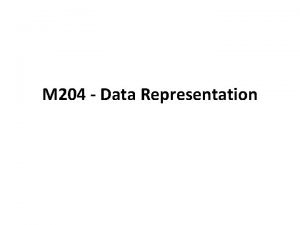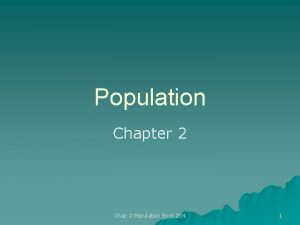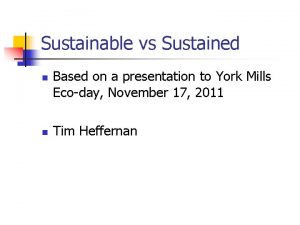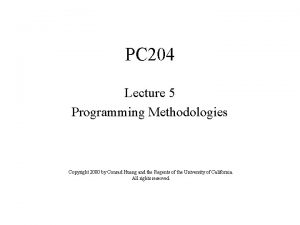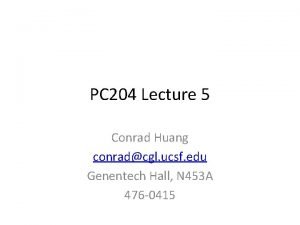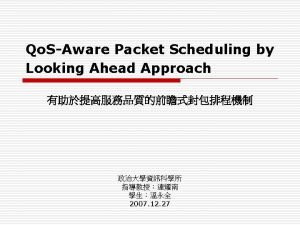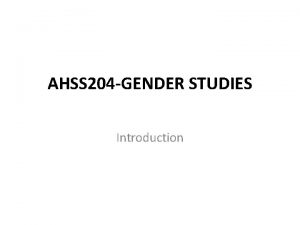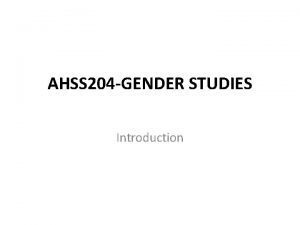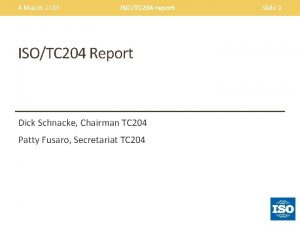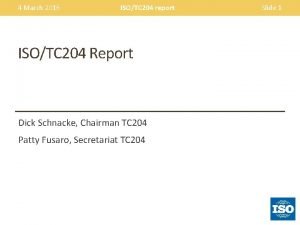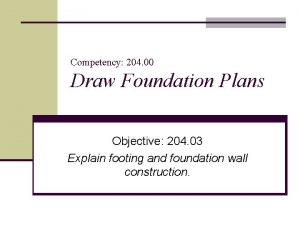AHSS 204 GENDER STUDIES Introduction Gender is related








































- Slides: 40

AHSS 204 -GENDER STUDIES Introduction

“Gender” • is related to culture and the social division into “masculine” and “feminine”. • Gender therefore pertains to the qualities, tastes, aptitudes, roles and responsibilities associated with men and women in a society. • Definitions of masculine and feminine vary enormously – demonstrating their social origin – since every society develops its classification on the basis of its own criteria and principles. • The concepts of masculinity and femininity are not developed independently of each other but are mutually dependent.

Gender studies • An interdisciplinary filed studies gender identity and gender representation. The field includes women's studies feminist studies, men's studies and queer studies. • It studies gender and sexuality in the fields of literature, language, geography, history, political science, sociology, anthropology, cinema, media studies, human development, law, public health and medicine. • It also analyzes intersection between how race, ethnicity, location, class, nationality, and disability.

Man or Woman? Is it important?

We learn gender roles in early ages

• Simone de Beauvoir said: "One is not born a woman, one becomes one. " This view proposes that in gender studies, the term "gender" should be used to refer to the social and cultural constructions of masculinities and femininities and not to the state of being male or female in its entirety.

Gender signs

(♀♂) • • Nature/culture femininity/masculinity Man/woman private/public • Women exclusion from the paid work help to lover the minimum vage. • if women are kept in the house life expences such as child care, food, cleanning, elderly care, etc. can be reduced and the responsibilty of government will not be questioned. • A huge propaganda on keeping women indoor. • Violence tolerated as form of control.

Sam Killermann: gender • According to Sam Killermann, Gender can also be broken into three categories, • gender identity, • gender expression, • and biological sex. • These three categories are another way of breaking down gender into the different social, biological, and cultural constructions.

The Social construction of Gender and Sex • Recently sociologists have been discussing that both sex and gender are culturally constructed. Not only gender but also human body itself is subject to social forces as we consider about piercing, dieting, even sex change operation etc. . . • The perspective accepting the biological basis of gender believes that sex provides a social framework for gender roles. Contrary to this argument, second group sees both sex and gender to be socially constructed. Sex differences are used to shape those differences socially.

Perspective on Gender Inequality • Functionalists Division of labour between men and women is biologically based and universal. Women are attached to domestic and family responsibilities while men to outdoor duties. Nuclear family in industrial societies is the key agency of socialization. Women are defined with their expressive roles, men are instrumental roles and these roles are complementary (T. Parsons). Mother is crucial for child’s socialization. A child separated from the mother may have social and psychological difficulties in his/her adulthood. Even a mother substitute should be a woman (J. Bowlb).

Perspective on Gender Inequality Liberal Feminism • Women’s subordination is not a part of social system. Thus equal opportunities and access for women are needed for gender equality. Radical Feminism • They offered a new concept, patriarchy which is historical systematic cross cultural domination of females by males. • Men control women’s biological reproduction and labour. • The family contains variety of disadvantages for women. • They debate on sexual harassment, rape, pornography, violence against women, social pressure of western beauty over women. • For media studies, the most important contribution of radical feminists is the argument of women’s objectification through the media. Black Feminism • Women’s struggle is not only the struggle of white middle class women. • Other feminist did not consider ethnic women’s double burden, being woman and ethnic. • In black feminism, family represents a main point of solidarity against racism. • Gender equality without taking into consideration black women cannot be reached.

Social construction of sex and gender • Not only gender but our body is a cultural product as well: • Sex change operations • Body building • Diet • Tatoo • piercing. . .

Femininities Masculinities and Gender Relation Gender and Power by R. W. Connell • Masculinities cannot be understood separate from femininities, • Gender relations organized around men’s dominance are seen in daily practices, collective social arrangements. • Gender relations are constituted in three realms of society: Labour (gender division of labor), power (authority in institutions like family, state) and cathexis (emotional). • Gender regime is the configuration of gender relations within a particular setting, such as school, a family or a neighborhood.

Gender Hierarchy by Connell • There are different expressions of femininity and masculinity. • Ideal types of masculinities is hegemonic masculinity which is associated to heterosexuality, marriage, authority, paid work, physical and emotional toughness. • Emphasized femininity is complementary to hegemonic masculinity, serving interests and desires of men.

Transforming Masculinities Gender relations are open to change and challenge. Crisis in Masculinity Crisis of institutionalization: Weak men power in institutions and men’s power is underminded. Crisis of Sexuality: Heterosexuality is not dominant. Crisis in Interest formation: women friendly regulations, anti-sexist attitudes.

Private sphere: indoor &reproduction


Public sphere: outside

Feminist Movements Liberal Feminism Marxist Feminism Socialist Feminism Radical Feminism Black Feminism

Feminist contributions «The Private is Political» «The Personal is Political» Carol Hanisch • Is the motto of second wave feminism • It underscored the connections between personal experience and larger social and political structures since 60 s, 70 s, and until today • it is a challenge to the nuclear family and family values which has been exacerbated

Sylivia Walby: Theorising Patriarchy • There is no unchanging and uniform oppression over women in the world. Patriarchy changes according to other conditions and works harmoniously with other forms of oppression like capitalism. Walby describes six patriarchal structures: -in production relation; -in paid work; -in state; -in male violence; -in sexuality; -in cultural institutions.

UNDERSTANDING THE DIFFERENCE BETWEEN SEX AND GENDER • In many cultural contexts, the differences between girls and boys, and between men and women, are regarded as natural. • Children are classified at birth – usually by observing their genitals – into two categories: male and female. On the basis of the category to which they belong, society will consider them qualified to do certain things and expect certain attitudes and behavior of them. • Their rights and duties and their social, economic and political roles will be different during their childhood and throughout their adult lives.

Thus the anthropologist Margaret Mead, studying traditional societies in Oceania in the first half of the twentieth century remarked on • “the conspicuous facts of age and sex. . . , whether it be the convention of one Philippine tribe that no man can keep a secret, • the Manus assumption that only men enjoy playing with babies, • the Toda prescription of almost all domestic work as too sacred for women, • or the Arapesh insistence that women’s heads are stronger than men’s. ”

In many contemporary societies, these assertions could be reversed: women are considered more talkative than men, they are supposed to be naturally maternal, they are also thought to be better qualified to do domestic work. In some cultures, women carry a heavy load (in the Maghreb, for example) or maintain the roads (in Russia), whereas in others, they are believed to be physically too weak for such work. • This calls into question the naturalization of gendered identities. Differentiation between boys and girls and between men and women is based on anatomical differences, • but it is also a social construct. The concepts of “sex” and “gender” lead to a clearer understanding of the two elements in gendered identities. • •

It is common for sex and gender to be confused. • Biological differences between the sexes are the basis on which social differentiation of masculine and feminine is naturalized, and this is then considered beyond question. • The fact of being born male or female is, therefore, not sufficient in itself for a person to become a girl or a boy and, subsequently, a woman or a man within the social roles laid down by the society in which that person lives. • For this to happen, a learning process must take place from the moment that he or she is born.

The person will be confronted with expectations and requirements and also experience treatment, opportunities and events that will differ according to that person’s sex. • This experience will enable the person to assimilate all characteristics and roles assigned to both genders. • The daily learning process begins in the family and is continued by the institutions and members of society as a whole. • The gendered constraints imposed by society are thus internalized as natural.

As Simone de Beauvoir said, “One is not born a woman, one becomes one” similarly, one is not born a man but one becomes one. • These internalized gendered constraints provide a new understanding of the inequalities which exist between men, women and LGBT people. • These inequalities lead to a male/female bipolarization in all societies which is accompanied by the construction of a hierarchy. • Like social differentiation between the sexes, this hierarchy ought not to be legitimized by biological differences.

Consequently, gender-sensitive policies and measures are designed to promote women in all spheres. It should be noted that gender relations and gender identities can also have adverse effects on men: • excess male mortality, for example, can be explained in part by types of social behavior associated with masculinity: drinking, smoking, speeding, and so on. • Schools and textbooks are fundamental to the learning of gendered roles. Representations of male and female are legitimized here by a high-status medium. • Once assimilated by children, the “gender system”, that is “the set of norms, beliefs, practices and knowledge that organizes relations between men and women”, will have repercussions on girls’ academic achievement and choices as well as on their experience as a whole. • It is from this angle that textbooks may be investigated as potential vehicles for gender equality.

United Nations Convention on the Elimination of All Forms of Discrimination against Women (CEDAW), • The Convention on the Elimination of All Forms of Discrimination against Women (CEDAW), adopted in 1979 by the UN General Assembly, is often described as an international bill of rights for women. Consisting of a preamble and 30 articles, it defines what constitutes discrimination against women and sets up an agenda for national action to end such discrimination. • ". . . any distinction, exclusion or restriction made on the basis of sex which has the effect or purpose of impairing or nullifying the recognition, enjoyment or exercise by women, irrespective of their marital status, on a basis of equality of men and women, of human rights and fundamental freedoms in the political, economic, social, cultural, civil or any other field. "

By accepting CEDAW States commit themselves to undertake a series of measures to end discrimination against women in all forms, including: • to incorporate the principle of equality of men and women in their legal system, abolish all discriminatory laws and adopt appropriate ones prohibiting discrimination against women; • to establish tribunals and other public institutions to ensure the effective protection of women against discrimination; and • to ensure elimination of all acts of discrimination against women by persons, organizations or enterprises.

Gender mainstreaming • The (re)organisation, improvement, development and evaluation of policy processes, so that a gender equality perspective is incorporated in all policies at all levels and at all stages, by the actors normally involved in policy-making. • Women and men have different needs and living conditions and circumstances, including unequal access to and control over power, resources, human rights and institutions, including the justice system. • The situations of women and men also differ according to country, region, age, ethnic or social origin, or other factors. The aim of gender mainstreaming is to take into account these differences when designing, implementing and evaluating policies, programmes and projects, so that they benefit both women and do not increase inequality but enhance gender equality. • Gender mainstreaming aims to solve –sometimes hidden- gender inequalities. It is therefore a tool for achieving gender equality.

• Gender Stereotypes are ideas that people have on masculinity and femininity: what men and women of all generations should be like and are capable of doing. (e. g. , girls should be obedient and cute, are allowed to cry, and boys are expected to be brave and not cry, women are better housekeepers and men are better with machines, or boys are better at mathematics and girls more suited to nursing). • Gender-Based Violence is violence derived from gender norms and roles as well as from unequal power relations between women and men. Violence is specifically targeted against a person because of his or her gender, and it affects women disproportionately. It includes, but is not limited to, physical, sexual, and psychological harm (including intimidation, suffering, coercion, and/or deprivation of liberty within the family or within the general community). It includes violence perpetuated by the state.

empowerment Empowerment refers to the expansion of people’s capacity to make and act upon decisions (agency) and to transform those decisions into desired outcomes, affecting all aspects of their lives, including decisions related to health. It entails overcoming socioeconomic and other power inequalities in a context where this ability was previously denied. Programmatic interventions often focus specifically on empowering women because of the inequalities in their socioeconomic status.

"a struggle for women by men". : heforshe • • He. For. She is a solidarity campaign for the advancement of gender equality, initiated by UN. Its goal is to achieve equality by encouraging both genders to partake as agents of change and take action against negative stereotypes and behaviors. • Grounded in the idea that gender inequality is an issue that affects all people—socially, economically and politically—it seeks to actively involve men and boys in a movement. • On the He. For. She website, a map—which uses a geo-locator to record global engagement in the campaign—counts the number of men and women around the world who have taken the He. For. She pledge The campaign website also includes implementation plans for UN agencies, individuals and civil society, as well as those on university and college campuses, both through online and sustained engagement. [ Lastly, the He for She campaign shows progress towards their goal is by highlighting the work many of the He for She campaign supporters have done. • • • https: //www. heforshe. org/en

The private is political «The Private is Political» «The Personal is Political» Carol Hanisch • It underscored the connections between personal experience and larger social and political structures since 60 s, 70 s, and until today • Public/Private Sphere «Violence Against Women» CEDAW & Istanbul Agreement «Family Protection Law 4320» • promulgated on 4 th January 1998 which addresses the state intervention into the private sphere for the first time with the aim of dealing with cases of VAW and the protection of women. • The law is not only related to VAW but to all family members within the family. Nurten Kara

Spivak: «epistemic violence» • means the infliction of harm against subjects through discourse. • occurred through the marginalization of certain voices (within Western discourses) that belong to the "subaltern". • It is similar to Said's idea of "otherness" in Orientalism. Nurten Kara

Epistemic Violence in the Process of Othering • Epistemological violence refers to the interpretation of social-scientific data on the Other and is produced when empirical data are interpreted as showing the inferiority of or problematizes the Other, even when data allow for equally viable alternative interpretations.

Pierre Bourdieu: symbolic power • For Bourdieu, this was a ‘worldmaking power’: giving those holding the power the ability to impose their vision of the social world, and its divisions, as legitimate. • “to impose the means for comprehending and adapting to the social world by representing economic and political power in disguised, taken-for-granted forms”.

Stemming from the concept of symbolic violence is epistemic violence, which focuses on the discourse involved in the practice of othering. • Othering, to this effect, is the marginalization of those who are distinctly different from the majority ‘us’, and uses differences between beliefs and customs to define them as the out-group (Rawls & David, 2003). • Traditionally, societies have used the discourse of otherness to create a common bond within the in-group • Often in an asymmetrical conflict in which one group has markedly more symbolic power, the powerful will exercise this power through epistemic violence. • The discursively-produced sense of division that follows deeply and negatively effects the oppressed and often leads to physical violence and conflict
 Paradigm shift from women studies to gender studies
Paradigm shift from women studies to gender studies Physical fitness two types
Physical fitness two types What is skill-related fitness? *
What is skill-related fitness? * Strategic gender needs and practical gender needs
Strategic gender needs and practical gender needs What is the importance of gender studies
What is the importance of gender studies Szpv 204
Szpv 204 Nkb 204
Nkb 204 What is a bit
What is a bit 204 e holly ave sewell nj 08080
204 e holly ave sewell nj 08080 Project arrow 204
Project arrow 204 Revised bp form 202
Revised bp form 202 204
204 Nbn s21 204
Nbn s21 204 Wordle 204 3/6
Wordle 204 3/6 204/90 simplified
204/90 simplified Como se leen decimales
Como se leen decimales Como escribir numeros decimales
Como escribir numeros decimales On average 113 204 aluminum cans
On average 113 204 aluminum cans Polonium 204 vergiftiging
Polonium 204 vergiftiging Polonyum 204
Polonyum 204 En 60204-1.
En 60204-1. Far52.204-21
Far52.204-21 On average 113 204 aluminum cans are recycled in a minute
On average 113 204 aluminum cans are recycled in a minute Pc 204
Pc 204 Afi 31-201
Afi 31-201 Dfars 252 204 7012
Dfars 252 204 7012 Rdsn 204
Rdsn 204 Pc 204
Pc 204 Pc 204
Pc 204 Nkb no 47b
Nkb no 47b Bernhard pfahringer
Bernhard pfahringer Comp 204
Comp 204 Sex 204
Sex 204 Introduction vs related work
Introduction vs related work Cultural studies
Cultural studies Higher modern studies essay structure
Higher modern studies essay structure Higher modern studies essay structure
Higher modern studies essay structure Film genres ppt
Film genres ppt Weather studies introduction to atmospheric science
Weather studies introduction to atmospheric science American meteorological society
American meteorological society An introduction to game studies
An introduction to game studies







